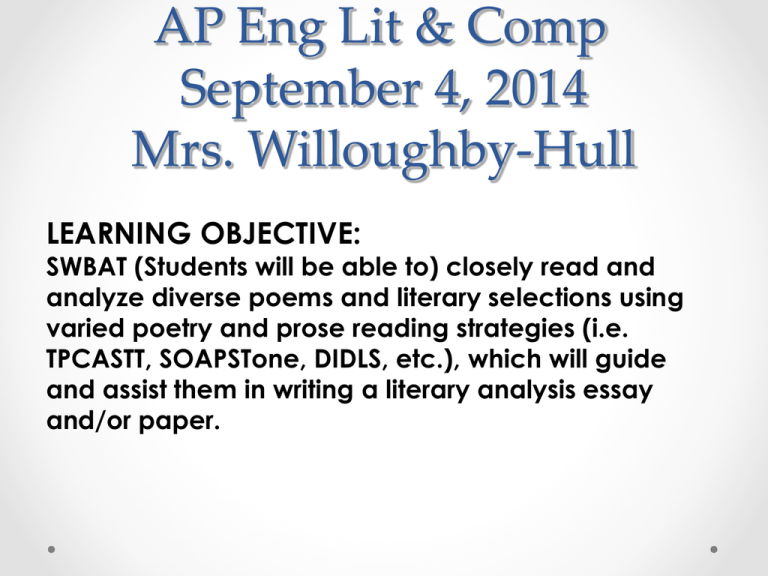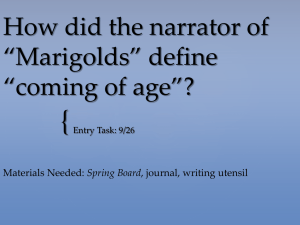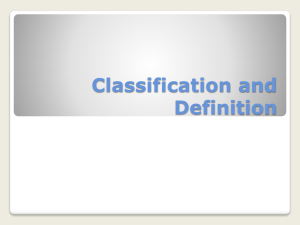soapspara
advertisement

AP Eng Lit & Comp September 4, 2014 Mrs. Willoughby-Hull LEARNING OBJECTIVE: SWBAT (Students will be able to) closely read and analyze diverse poems and literary selections using varied poetry and prose reading strategies (i.e. TPCASTT, SOAPSTone, DIDLS, etc.), which will guide and assist them in writing a literary analysis essay and/or paper. Review of Poetry Strategies Agenda Thursday, September 4, 2014 1. Do Now: Homework Review& Discussion – Interpretive Text – the use of “puns” in Romeo and Juliet by William Shakespeare 2. Summative Assessment - Poetry Analysis Essay 3. Teen Biz Article and Worksheet Questions? Clarifications before we start? LEARNING OBJECTIVE: SWBAT (Students will be able to) closely read and analyze diverse poems and literary selections using varied poetry and prose reading strategies (i.e. TPCASTT, SOAPSTone, DIDLS, etc.), which will guide and assist them in writing a literary analysis essay and/or paper. 1. Do Now: Homework Review & Discussion – Interpretive Text – the use of “puns” in Romeo and Juliet by William Shakespeare How long? 10-15 min LEARNING OBJECTIVE: SWBAT (Students will be able to) closely read and analyze diverse poems and literary selections using varied poetry and prose reading strategies (i.e. TPCASTT, SOAPSTone, DIDLS, etc.), which will guide and assist them in writing a literary analysis essay and/or paper. 2. Summative Assessment – Poetry Analysis Essay How long? 50 minutes! Poetry Analysis Essay PROMPT: The following poem is by contemporary poet Li-Young Lee. Read the poem carefully. Then write a well-developed essay in which you analyze how the poet conveys the complex relationship of the father and the son through the use of literary devices such as point of view and structure. Questions? Clarifications before you start? Agenda (contin.) Final Assignment for the Day! 3. Using Achieve3000, read one of your Articles for the week and complete the Achieve3000 worksheet, including the summary How long? 40-50 min Note: Scores need to be 75% or higher or a new article and worksheet must be completed including the summary! AP Eng Lit Objective • SWBAT (Students will be able to) closely read and analyze diverse poems and literary selections using varied poetry and prose reading strategies (i.e. TPCASTT, SOAPSTone, DIDLS, etc.), which will guide and assist them writing a literary analysis essay or paper. SOAPSTone An introduction to Literary/Poetry Analysis Mrs. Willoughby-Hull What is SOAPSTone? • Speaker: The voice that tells the story • Occasion: The time and the place of the piece; the context that prompted the writing. • Audience: The group of readers to whom this piece is directed • Purpose: The reason behind the text • Subject: The topic of the piece of writing • Tone: The attitude of the author Speaker • While reading the text, ask yourself this major question: WHO IS SPEAKING? • Don’t confuse the author with the speaker. They are two different voices; sometimes two different personas. For example, Jim is a reporter for the NY Times, but the speaker is a man trying to influence readers to steer clear of a new product. • Ask yourself: What’s the point of a speaker? Why do we care who is speaking? How does it influence the text? How does it influence the reader? • Who is speaking to the reader? Is it an economist? A fashion guru? A teacher? A lawmaker? Occasion • While reading, it’s important to determine WHAT EVENT INFLUENCED THE TEXT. • Why do we write? Why does it matter? Do we just write about anything and everything, or are we influenced to write? • Ask yourself: Why is this person writing this text now? What major event or occurrence inspired this piece of writing? • Are they writing in response to a new law? An ongoing war? A celebrity mishap? A major world crisis? Audience • While reading the text, it is important to determine WHO THE AUDIENCE IS. • Don’t think an article on the health risks of elementary school cafeteria food is an article for just anyone. Who could an article like that be targeting? • Ask yourself: Who is the intended audience for this text? Why write to this specific audience? Why cant a piece of writing be meant for EVERYBODY? • Is the audience the financial experts of the business world? Stay-at-home mothers? College students? Athletes? Purpose • While reading the text, it is necessary to understand the PURPOSE OF THE TEXT. • Ask yourself: What’s the purpose of the writing? What is it intended to do? What is the speaker hoping to achieve? Is there a goal? • Are they trying to influence consumers to buy a certain product? Vote for a specific politician? Save their money by investing? Send their kids to private school? Subject • While reading the text, determine the SUBJECT OF THE TEXT. • Ask yourself: What is this piece of writing about? What topic(s) does it concern? Why does it matter? • Are they writing about the war in Iraq? A new law that just passed? A hot, new celebrity? Tone • While reading the text, one of the most important questions is WHAT’S THE TONE OF THE TEXT? • How is the author saying what he’s saying? What is his attitude towards the subject? Towards the audience? • Is he angry? Biased? Persuasive? Neutral? The Analysis Paragraph • An analysis paragraph must prove something by using the text as evidence. • Follow the specific paragraph outline if you want to write an outstanding paragraph. DO’s and DON’TS: DO state your point in the topic sentence DON’T forget to provide the WHY and HOW SO? DO cite your evidence DON’T use a quote without explaining its significance • DO follow the paragraph outline • • • • • An Outline of an Analysis Paragraph • Topic Sentence (TS): One sentence that states your point; it states what you’re trying to prove. • Concrete Detail (CD #1): Your first piece of evidence; a quote from the source. • Commentary (CM): Two to four sentences that explains the significance of the quote. How does it help prove your point? • Concrete Detail (CD #2): Your second piece of evidence; another quote from the source. • Commentary (CM): Two to four sentences that explains the significance of the quote. How does it help prove your point? • Conclusive Sentence (CS): One sentence that wraps up your paragraph. Sample Topic Sentence • In "Why Reliance on Technology is a Bad Thing," John Grohol’s purpose is to (inform/persuade/etc.) (whom) about (what). • Sample: In "Why Reliance on Technology is a Bad Thing," John Grohol's purpose is to awaken technology dependents about the risk of relying so heavily on technology in order to function daily. • Sample: “In Parenting Experts Weigh in on ‘Tiger Mother,’” Eryn Brown, a writer for the Los Angeles Times, writes to an audience of parents in order to promote high expectations for children, but not by damaging their well-being. Model Paragraph • TS: In “Why Reliance on Technology is a Bad Thing,” John M. Grohol’s purpose is to inform technology dependents that what they cant live without, will one day replace them. • CD #1: “We’re constantly seeking out short-term gains and improvements without really taking into consideration the whole picture for future generations” (Grohol 1). • CM: Self interest is getting in the way of personal growth because machines are created so creators can be lazy. But this laziness will eventually lead to the creators being replaced by a machine that will get the job done. Model Paragraph cont. • CD #2: In addition, Grohol comments on people looking for shortcuts as he states, “I suspect some new architects would know how to design a 50story building on paper” (Grohol 2). • CM: Dependency on technology equals weakness. Fifty years ago, people were able to survive without technology. Unfortunately, the 2011 generation is useless without technology, which allows them to be controlled and taken over by computers, etc. • CS: In conclusion, some humans have become too lazy to operate and have become addicted to machines; the easy way out isn’t always the right way. Citing within your Paragraph • You must ALWAYS support your point with textual evidence and give credit where credit is due=acknowledge the author. • Introduce the material being cited with a acknowledgement phrase that includes the author's name and title. • Notice that the period follows the parenthetical citation. When a quotation ends with a question mark or an exclamation point, leave the end punctuation inside the quotation mark and add a period after the parentheses: " . . . !" (8). • Example: James Smith, a writer for the Orange Country Register, reports that shortly after California made it illegal to use a handheld phone while driving, "accidents caused by using the phones dropped by 75 percent" (A8). This proves that outlawing cellphones while driving is reducing accidents and ultimately saving lives. The law is an essential addition to California’s legislation. How to Answer Qs • A strong answer must respond to all parts of the question. • A strong answer must use textual evidence as support. Use proof! Insert a quote to support your answer. • A strong answer must answer the WHY and HOW SO? • Be thorough. Always re-read your answers before submitting them for a grade. • Always answer the question in complete sentences. • Don’t start with “Yes, because…” or “No, because…” How to Answer Qs • First, text-mark your reactions in the right margin. • Next, write the main topic of each paragraph in the left margin. • Discuss the article: what’s the main point? Whose voice is being heard? Who would need to know this? • Discuss the Q: what is this Q asking? How can I answer this Q in complete sentences? How can I support my answer? • Discuss what quotes you can use that best support your answer. • Re-read your Q and answer aloud to make sure you are answering the question properly. Answering Questions • 1. Do you find that the possibility of failing is a motivator? How would you and your classmates approach schoolwork differently if F’s were changed to incompletes? • How would you answer this question? • Where would you start? How would you start? • What quotes from the article can you use as support? • When can you insert your opinion? Sample Answer • The possibility of failing is a strong motivator to get kids to do their schoolwork. If they know their grade will continue to drop with every missing or incomplete assignment, then they will complete their work the first time. In the article, “At West Potomac High School, taking F Off the Grade Books,” Mary Mathewson, an English teacher, states, “the possibility of failing is a motivator, and now kids are under the impression they can do it whenever they want to and it’s not that big of a deal” (St. George 1). Taking the F off of the grade books sends the message to kids that they can choose to not do their work because they know an “Incomplete” means a second, a third, and maybe a fourth chance. I definitely think that if Katella HS adopted the “I” as a grade, our students would stop working all together. Lazy students will get lazier, average students will think failing is not a big deal, and the motivated students will stop trying as hard. Failing is one motivation tactic that works for students. I definitely don’t think replacing the “F” with an “I” will increase motivation, it’s just an easy fix to a major problem.








